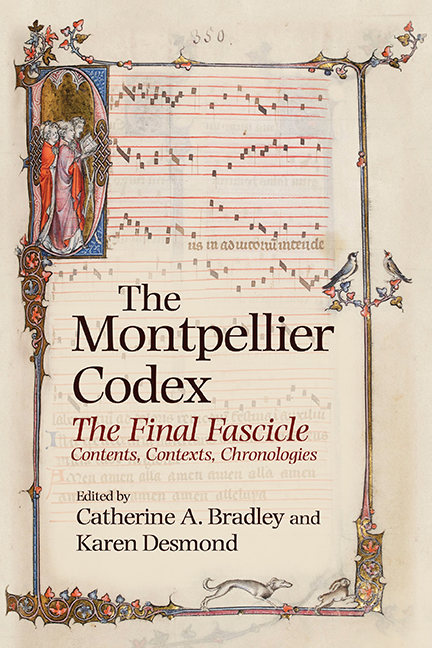Book contents
- Frontmatter
- Contents
- Figures
- Musical examples
- Tables
- Acknowledgements
- List of manuscript sigla
- Abbreviations
- Table of fascicle 8 contents
- Introduction
- I The Material Object
- 1 Montpellier 8: Anatomy of …
- 2 A Palaeographical Analysis of the Verbal Text in Montpellier 8: Problems, Implications, Opportunities
- 3 The Style and Iconography of Montpellier folio 35or
- 4 The Decoration of Montpellier 8: Its Place in the Continuum of Parisian Manuscript Illumination
- 5 Double Motet Layouts in the Montpellier Codex and Contemporaneous Libri motetorum
- 6 Deus in adiutorium Revisited: Sources and Contexts
- 7 Thematic Clusters and Compilational Strategies in Montpellier 8
- II INNOVATION AND TRADITION
- III ANALYTICAL CASE STUDIES
- Bibliography
- Contributors
- General index
- Index of compositions, alphabetical
- Index of compositions in Mo, manuscript order
- Miscellaneous Endmatter
4 - The Decoration of Montpellier 8: Its Place in the Continuum of Parisian Manuscript Illumination
from I - The Material Object
Published online by Cambridge University Press: 04 July 2019
- Frontmatter
- Contents
- Figures
- Musical examples
- Tables
- Acknowledgements
- List of manuscript sigla
- Abbreviations
- Table of fascicle 8 contents
- Introduction
- I The Material Object
- 1 Montpellier 8: Anatomy of …
- 2 A Palaeographical Analysis of the Verbal Text in Montpellier 8: Problems, Implications, Opportunities
- 3 The Style and Iconography of Montpellier folio 35or
- 4 The Decoration of Montpellier 8: Its Place in the Continuum of Parisian Manuscript Illumination
- 5 Double Motet Layouts in the Montpellier Codex and Contemporaneous Libri motetorum
- 6 Deus in adiutorium Revisited: Sources and Contexts
- 7 Thematic Clusters and Compilational Strategies in Montpellier 8
- II INNOVATION AND TRADITION
- III ANALYTICAL CASE STUDIES
- Bibliography
- Contributors
- General index
- Index of compositions, alphabetical
- Index of compositions in Mo, manuscript order
- Miscellaneous Endmatter
Summary
YVONNE Rokseth would be surprised and pleased to know that a two-day conference devoted entirely to the last fascicle of the manuscript she so carefully edited in the 1930s, some eighty years ago, took place in March 2014. Her work is still the starting place for any research on Mo. The opening folio of Mo 8, fol. 350r (see the front cover of this volume), is now a familiar image. Although fascicle 8 has only this single historiated initial of singing clerics on its first folio, each motet in the nearly fifty following folios begins with illuminated initials that decorate the margins of the page with leaves, vines, and occasional dragons.
Since the work of Robert Branner in the 1970s, it has been generally accepted that fascicles 1–7 of Mo were illuminated by artists active in Paris in the second half of the thirteenth century. But because Branner considered fascicle 8 to be later (c.1300) than the scope of his book, he had little to say about it. We can presume that, when the manuscript was first produced, its folios were somewhat larger, particularly at the top margin. The folios are now c.192 × 136mm; the textblock (written space) is c.128 × 77mm. Fascicle 8 was carefully trimmed for binding so as not to cut off any of the decoration that occupies the margins outside the textblock. Rokseth believed that fascicle 8 was not originally bound with fascicles 1–7, beginning with an independent life and its own foliation. At some point fascicles 1–7 were all trimmed to match the size of the folios in fascicle 8, sometimes clipping some of their decoration at the edges. But we do not know whether fascicle 8 was joined to the seven earlier fascicles prior to the manuscript's current binding from the seventeenth or eighteenth century.
The tonsured clerics singing before a book on a lectern as depicted in the Mo 8 initial (see Figure 3.1a) come from a long line of illustrations for Psalm 97, Cantate domino canticum novum (‘Sing to the Lord a new song’). But they reflect actual practice, for on major feasts the solo singers in the choir of Notre-Dame in Paris would come down out of their stalls to sing from the eagle lectern that stood in the centre aisle between the two sides of the choir.
- Type
- Chapter
- Information
- The Montpellier CodexThe Final Fascicle. Contents, Contexts, Chronologies, pp. 78 - 89Publisher: Boydell & BrewerPrint publication year: 2018

